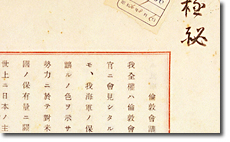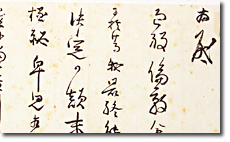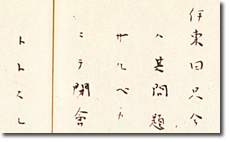HOME > Taisho Democracy > c. The Era of Party based Government > London Naval Conference
3-17 London Naval Conference

Movement protesting the London Naval Conference 3 April 18, 1930 (Showa 5). From "Zusetsu Kokumin no Rekishi. Vol.15"
The twin policy pillars of the HAMAGUCHI Cabinet were a conciliatory foreign policy and fiscal restraint. The sine qua non was the conclusion of the London Naval Treaty. The treaty negotiations had focused on the extent of naval disarmament by the negotiating powers (Britain, America, Japan, France and Italy), with restrictions to be placed on the aggregate tonnage of auxiliary ships (cruisers, destroyers, submarines, etc.). On 26 November 1929 (Showa 4), the HAMAGUCHI Cabinet held a meeting and resolved to demand that Japan's aggregate tonnage of both auxiliary ships and heavy cruisers be limited to 70% of America's levels, while keeping submarines at the current level of 78,000 tons. However, the United States strongly objected to those terms, and in the end the Japanese Government conceded on the matter of heavy cruisers, and accepted a 10:10:6 ratio, with the total tonnage of all auxiliary ships (including cruisers) raising it to some 70% of American levels. The Japanese representatives signed the Treaty on 22 April 1930 (Showa 5). The Minister of Foreign Affairs SHIDEHARA Kijuro sent Home Minister MAKINO Nobuaki a letter with an attachment describing the negotiations process at that time.
Chief of General Staff KATO Hiroharu, however, who was thought to have accepted the compromise proposal at one point, tried to appeal to the Emperor to block the Treaty, presenting a report opposing its restrictions. That led to the Navy's claim that the signing of the London Naval Treaty in fact violated the Emperor's prerogative of supreme command, as it overrode the objections of his Chief of Staff. This in turn, led to vehement attacks on the Government by the General Staff, the Seiyukai (Association of Friends of Constitutional Government), and civilian right-wingers. This is known as the issue of the usurpation of the prerogative of supreme command, however, backed by the only surviving Genro Saionji, senior statesmen, and public opinion, the HAMAGUCHI Cabinet was able to overcome the opposition to the Naval Treaty in the Diet, and compelled the Privy Council to deliberate on it before ratification. Eventually, the Treaty was ratified by the Japanese Government on 2 October 1930 (Showa 5).
The Privy Council President, at the time of the Naval Treaty deliberations, KURATOMI Yuzaburo, later wrote in his memoirs (Kitsugai Shimatsu), a detailed account of the exchange at that time between Navy Minister TAKARABE Takeshi and the Privy Councilors over the usurpation of the prerogative of supreme command.
Full Account of Japan's Position at the London Conference
- 7 June 1930 (Showa 5)
- Papers of MAKINO Nobuaki, Document #514
- National Diet Library
SHIDEHARA Kijuro's Letter to MAKINO Nobuaki
- 7 June 1930 (Showa 5)
- Papers of MAKINO Nobuaki, Document #514
- National Diet Library
Kitsugai Shimatsu (A Memoir)
- 3 May 1937 (Showa 12)
- Papers of KURATOMI Yuzaburo, #34
- National Diet Library


